Travel
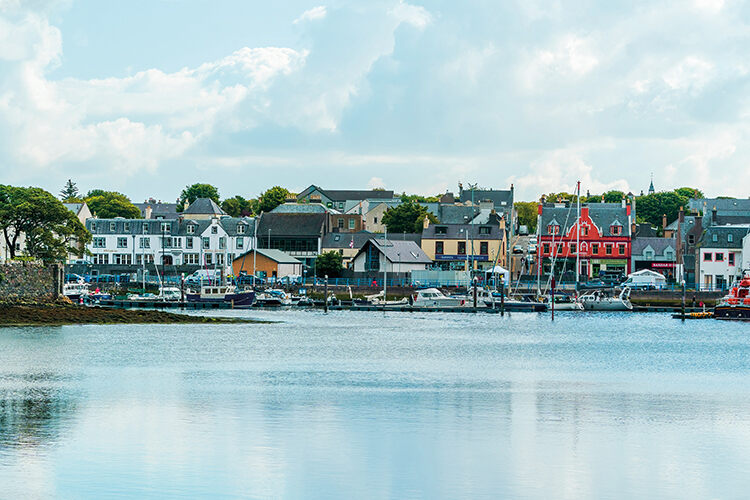
Few places in the UK epitomise living off the land like the Outer Hebrides, as Mark Rowe discovers on a food and drink tour of Lewis and Harris
Do you remember what meals your granny cooked you as a child?’ asks Allan MacRitchie. It’s not a question I’m expecting, even though MacRitchie is a chef and we’re speaking in his pop-up restaurant in a former village school. Before I can answer, MacRitchie continues: ‘I remember cycling to my grandmother’s croft, and she’d just pull a clootie dumpling [a Scottish pudding made with suet and raisins] out of the oven, freshly baked. How can I take that memory and put it into a clootie? It is the story behind a specific dish that must be served along with it. I can’t just throw a dumpling on the plate. I want the golden syrup my grandmother used, but you can’t just ladle that on, so I make a sorbet out of it.’
For MacRitchie, cooking means embedding the culture and landscape of his island home, right at the top of Lewis in the Outer Hebrides, into every meal he prepares. He throws another rhetorical question at me. ‘I can make a damned good chilli if someone wants it – a Michelin-star-quality one – but how do you judge whether one dish is better than another? A lot of people here say the best cup of tea they ever drink is while they are out cutting peat. Is it the tea, or the fact they’re cutting peat, or the heather blossom or the drowned midge in the tea that makes it great?’
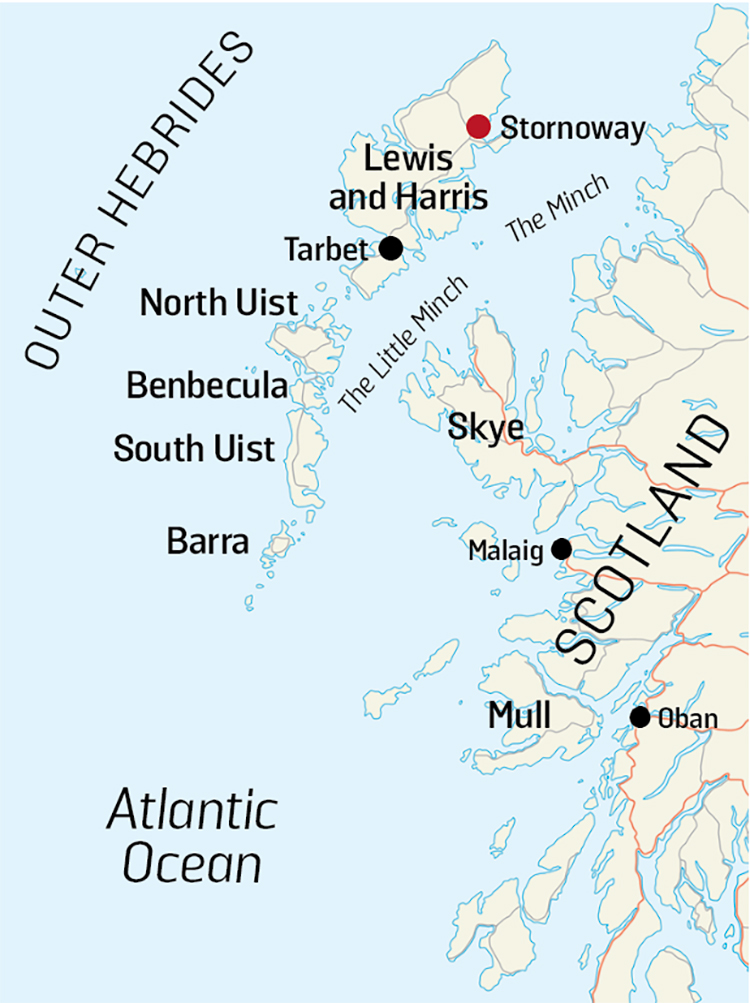
Known as the Niseach Chef (a Niseach is anyone from the Ness area), MacRitchie describes his pop-up menus as offering ‘street food’, though his streets are most definitely roads less travelled and more likely to be peat tracks that fizzle out in moors or coastal sea meadows. I try his locally caught lobster and Scotch egg, using local duck eggs, plated, he says, ‘so it was as if you were walking on the machair [grasslands] with different taste sensations and aromas’.
Until recently, any self-respecting gourmand would halt their Highlands and Islands foodie tour in Skye, on the east side of the Minch from the Outer Hebrides. Now, however, if they wish to taste the best food in the region they are going to have to hop on a ferry across the ever-playful waters of the northeast Atlantic. Long gone are the days when the islanders of the Outer Hebrides were patronised for catching seabirds and boiling them up for soup. A trend for fine dining is emerging on the Outer Hebrides that draws upon the coastal waters, wild moors and crofts of the islands.
When the Michelin inspectors finally waddle off a ferry in Tarbet, the only sizeable village in Harris, a short uphill stroll will sharpen the appetite for their first dining experience. Based in what a casual glance suggests is a hipster shipping container, a rectangle of exposed steel with floor-to-ceiling windows, Chris Loye, chef of Flavour is preparing an eight-course fine-dining tasting menu, in which everything is drawn from the islands.
Loye, rather like the Niseach Chef, believes every dish tells a story – tales he shares with guests as they scoff courses of Lewis squid ceviche with cuckoo flower or creel-caught langoustines with seaweed caramel. ‘I tell them where the dish comes from, how I sourced it, how it fits into the island landscape and culture.’ Loye has spent years developing relationships with fishermen to source lobsters, crabs and langoustines, and build up his understanding of the landscape. ‘You come to learn where different seaweeds grow, we get venison from the island estates and you cannot beat the freshness of the fish. I can pick something off the boat at 5pm and it’s on a plate at 7.30 that night. Even one day of that fish being transported or hanging around will affect the quality.’
In the hours before opening for dinner, Chris and his partner Nicola collect seaweed and forage for flowers and chanterelle mushrooms on the moors. ‘Many flowers from the machair are edible and they’re a beautiful colour – they jump off the plate,’ he says. Cuckoo flower has ‘a wasabi taste’, according to Loye, flowers from willowherb add a pink colour to tea while the bitterness of silverweed adds a contrast to sun-dried tomatoes to make antipasto.
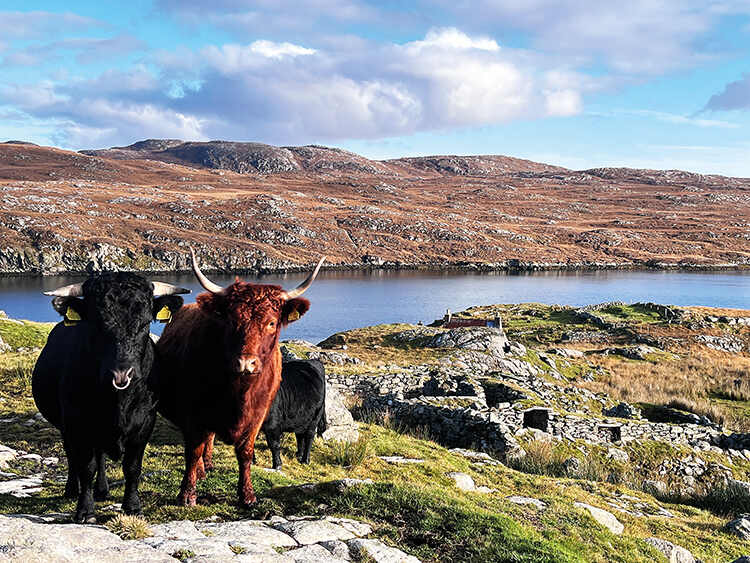
Small, independent food producers are sprinkled across the islands, including Brian and Melinda Whitington of Hebridean Charcuterie in Stornoway, the islands’ only town. The innovative range of flavours includes piquant spice mixes concocted by Syrian refugees who have made their home on Lewis, which are added to meat in a former garage on their croft, converted during lockdown into a production and drying unit.
‘This is the epitome of local, sustainable food production – we are a crofting community and many crofters keep a rare-breed pig as standard,’ says Brian. ‘The pigs are reared on good food, slaughtered locally, so there is no traumatic journey for them.’ Another source for the charcuterie is greylag geese. Climate change has made winters mild enough for the birds to remain in the Outer Hebrides all year round rather than migrating south and numbers are thought to be 20 times higher than is sustainable for the landscape, prompting the authorities to license their culling. Using venison has helped pay for an apprentice gamekeeper to be taken on in the community-run estate Stòras Uibhist in South Uist.
The chorizo packaging is eye-catching, made from corn starch and eucalyptus leaves because, says Whitington, ‘we get enough plastic blown across our beaches. At least if this ends up there it will break down quickly.’ Emblazoned on the packets is the image of a Lewis chessman, a respectful nod to the discovery of a 12th-century Norse chess set on the island’s west coast. ‘The Norse would never have made it across the North Sea if they hadn’t filled their boats with dried meats, so we’re echoing that heritage,’ he says with a wink.
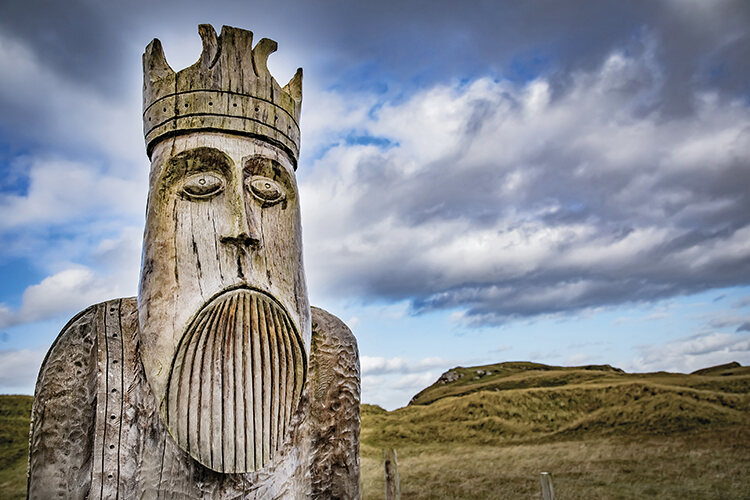
Some 56 kilometres west of Stornoway, in the rocky, almost primordial region of Uig, I follow a track through a ravine before emerging in the small but scattered township of Àird Uig, sitting below Gallan Head, where green pillar boxes, interspersed with shallow lochans inlaid with black sand, represent a desolate hangover from an old RAF base. The view is a blur of headlands and the bony geodesic silhouettes of the Uig hills. Here, at SEAcroft B&B, Andrew and Sarah Taylor-Gerloch serve up incredible three-course meals ranging from venison sausages hot smoked in their croft kitchen using a mixture of local black peat and oak wood sawdust to root vegetables from their polycrub. The Dexter cows on their croft (stumpy legged, which is handy for navigating the predominating steep-sided hills) produce delicately flavoured beef, the fillets seared and cooked sous vide.
‘Some people come to us for the food; others come here for the scenery and they are stunned by the food,’ says Andrew, who describes himself as a self-taught cook. (‘I’m not a chef,’ he says self-deprecatingly, ‘I just messed around at the cooker until I got something I liked.’) ‘Our driving passion is to use the local economy. Our lobsters are from local boats that operate along the Uig coast. Unlike commercial traders, they check their pots daily and land their catch quickly at Miavaig, six miles away. No food miles, no cruelty. Our lamb producers only keep half a dozen sheep.’

The ingenuity of the islands’ food producers invites the question of whether there is something in the Outer Hebridean air. History and self-sufficiency come into it, thinks Whitington. ‘In many respects, you’ve had to be tough and resilient on these islands. Otherwise, you would starve.’
Even though any such risk is mitigated nowadays by two supermarkets in Stornoway, the heritage of ‘thinking on your feet, stimulating creativity, still applies,’ Whittington argues.
Loye agrees that island life and the unique landscapes of Harris and Lewis are drivers of ingenuity. ‘The weather might be bad, the ferries not running, but you still have 20 people coming for dinner, so you have to make things happen. The very long winters also come into it. You don’t have five minutes to yourself in summer but when it quietens down you can get out, walk and get ideas.’ Although Loye is a trained chef, he reckons another driver is that people who’ve never cooked before give it a go and turn out to be quite good at it. ‘The islands are a bit of a blank canvas for all of us. It’s the need to do something. There is nobody else really doing it, so you just go for it.’
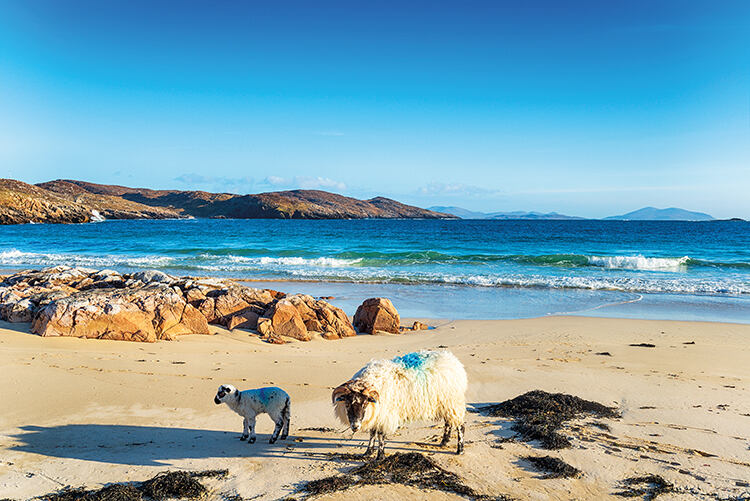
The only challenge, argues Whitington, is to make the wider world aware of it. ‘The temperament on the island is very understated, modest – there’s no swagger to anyone. All the innovation you could want is here but you’d be forgiven for not knowing about it. They need a megaphone to tell the world there is more here than black pudding.’
EXPLORE the Outer Hebrides
DON’T MISS
Callanish
These standing stones on the west coast of Lewis date back 5,000 years and provide a haunting spectacle that arguably surpasses that of Stonehenge. The central monolith and surrounding 13 stones were hewn from gneiss, the ancient rock that characterises much of the islands. Their provenance is still unclear, as they don’t align with any solstice, although it’s thought they may be linked to a periodic path of the full moon across the nearby Uig hills.
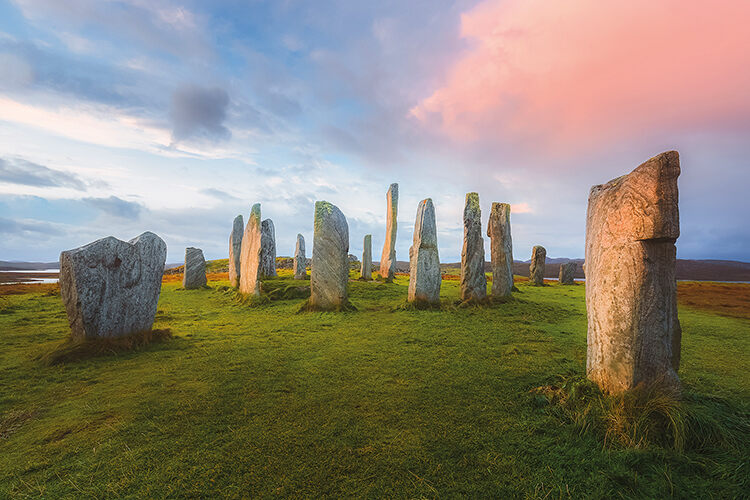
DRINK
To great fanfare, the Harris distillery produced its first malt, the Hearach, in 2023, yet a good 12 years earlier, the much smaller Abhainn Dearg, tucked away in a valley at Carnish in Uig on Lewis, produced the islands’ first single malt since 1929, bringing to an end centuries of illegal stills. Abhainn Dearg looks just how you would imagine a bootleg rig operating under the radar should: a handful of secluded outbuildings overlooking a sprawling river that clatters over glacial boulders on its way to the sea. The mush from the production process is spread far and wide among the island B&Bs to feed the hens that lay the breakfast eggs. Other whiskies are being laid down in Benbecula, South Uist and Barra; in the meantime gin keeps the distillery coffers ticking while they wait for the malt. Brewing is enjoying a revival with two new excellent breweries on Harris, the Loomshed and Isle of Harris; in both cases these family-run breweries make a feature of the soft water of Harris.
WILDLIFE
If you don’t see a white-tailed or golden eagle while visiting the Outer Hebrides you can consider yourself unlucky. Otters are also a decent bet. Other common wildlife includes eider duck, great skuas (known as bonxies), puffins, gannets, harbour porpoises, and common and grey seals, while you may even spot minke whales and orcas.
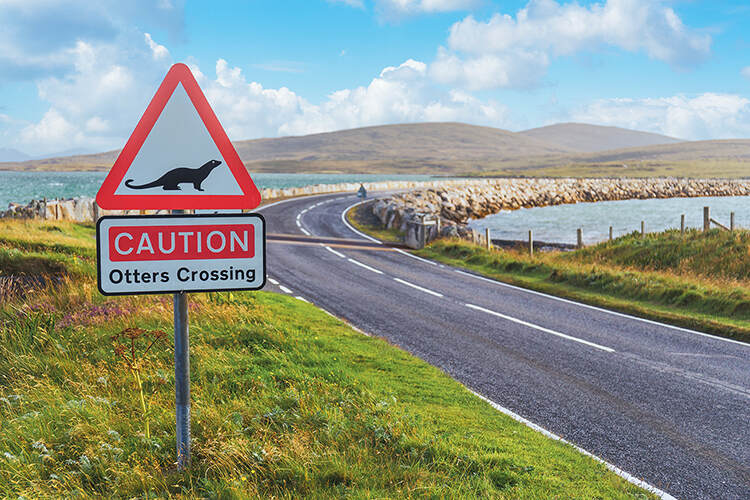
HONESTY BOXES
The Outer Hebrides take the concept of honesty boxes to a new level. In South Harris you will find Croft 36, run by Steve Olley, where you can grab soup, crab pasties and French patisserie-standard pastries (croft36northton.wixsite.com/home). A few miles down the road is Mustheb, where Heike Winter sells homemade organic mustard flavoured in varied ways, from honey to chilli, from what is, literally, a garden shed (hebrideanmustard.com). Others are scattered across the island, although they do come and go. Look out for machair potatoes – eat these floury gems and you’ll wonder why they don’t have the same cachet as Jersey Royals.
CYCLING
Cycling is a fantastic way to explore the quiet lanes off the main spinal roads that cut through the Outer Hebrides, find a loch by which to have a picnic, visit an ancient church or take in limitless sea views. The Hebridean Way is a dedicated route running from Vatersay in the south to the Butt of Ness in the far north and involves two ferries and several causeways. Be aware that although it’s magnificent, the route is more hardcore than its tourist-friendly marketing suggests.
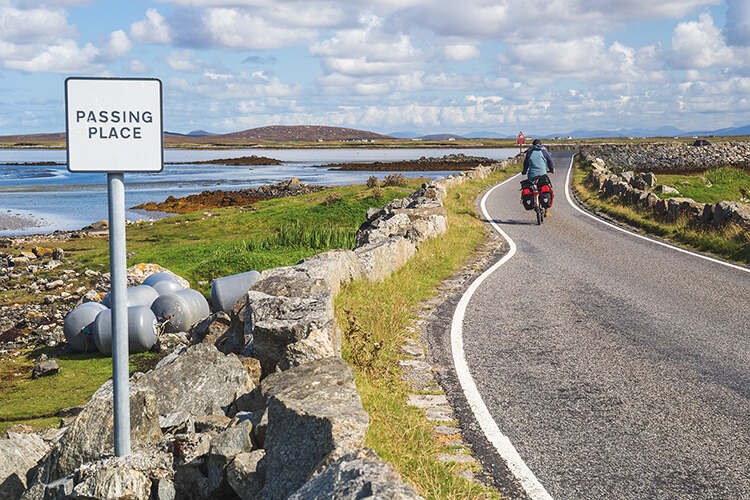
SURF LEWIS
Lewis has world-class surfing and crystal clear waters to explore. Surf Lewis offers lessons for individuals, families and groups with local, highly experienced, qualified instructors. Also paddleboarding and snorkelling classes. Private, tailored sessions are available across Lewis and Harris. Equipment hire available for the experienced. www.surflewis.com

GEARRANNAN BLACKHOUSE VILLAGE
A stunning place to stay or visit on a day trip, it features historic thatched blackhouse crofts overlooking a glorious bay, close to the Callanish Standing Stones. The museum offers vintage weaving demonstrations and fresh home-baking is availabe at the café. On the Hebribean Way cycle route.
www.gearrannan.com
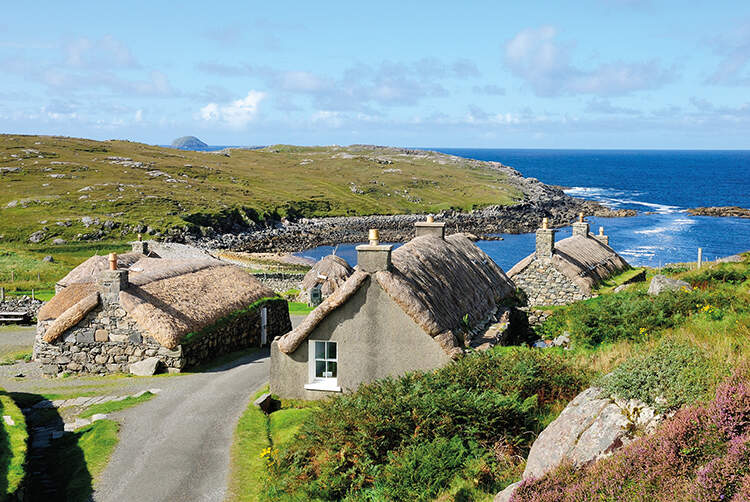
HEBRIDEAN HOPSCOTCH HOLIDAYS
Personalised island-hopping holidays organised by local experts who create bespoke itineraries. Packages including return flights from Glasgow, inter-island ferries, accommodation and car rental from £899 per person. Car-touring holidays, including return ferry trips from mainland Scotland, inter-island ferries and accommodation from £299 per person. www.hebrideanhopscotch.com, @hebrideanhopscotch
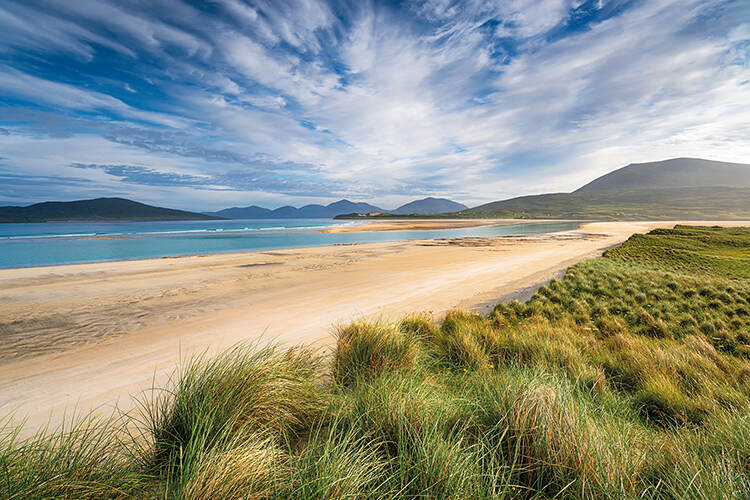
FIND OUT MORE
The local tourist board website (visitouterhebrides.co.uk) is full of useful information on activities and places to stay. The website’s section Eat Drink Hebrides is a comprehensive source of food producers, restaurants and cafes. Calmac Ferries (calmac.co.uk) sails to five ports across the islands. Loganair (loganair.co.uk) flies to Stornoway, Benbecula and Barra from the Scottish mainland.
Mark Rowe is the author of Outer Hebrides, published by Bradt.



